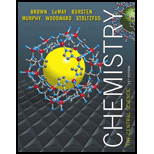
The rates of many atmospheric reactions are accelerated by the absorption of light by one of the reactants. For example, consider the reaction between methane and chlorine to produce methyl chloride and hydrogen chloride:
Reaction 1: CH4 (g) + C12 (g) → CH3 C1 (g) + HC1 (g)
This reaction is very slow in the absence of light. However, C12 (g) can absorb light to form C1 atoms:
Reaction 2: C12 (g) + hv → 2C1 (g)
Once the C1 atoms are generated, they can catalyze the reaction of CH4 and C12, according to the following proposed mechanism:
Reaction 3: CH4 (g) + C1 (g) → CH3 C1 (g) + HC1 (g)
Reaction 1: CH3 (g) + C12 (g) → CH3 C1 (g) + C1 (g)
The enthalpy changes and activation energies for these two reactions are tabulated as follows:
| Reaction | ΔH0(KJ/mol) | Ea (KJ/mol) |
| 3 | +4 | 17 |
| 4 | --109 | 4 |
By using the bond enthalpy for C12 (Table 8.4), determine the longest
Want to see the full answer?
Check out a sample textbook solution
Chapter 2 Solutions
Chemistry: The Central Science Plus Mastering Chemistry, 13th Edition
- Candle wax is a mixture of hydrocarbons. In the reaction of oxygen with candle w ax in Figure 11.2, the rate of consumption of oxygen decreased with time after the flask was covered, and eventually' the flame went out. From the perspective of the kinetic-molecular theory, describe what is happening in the flask. FIGURE 11.2 When a candle burns in a closed container, the flame will diminish and eventually go out. As the amount of oxygen present decreases, the rate of combustion will also decrease. Eventually, the rate of combustion is no longer sufficient to sustain the flame even though there is still some oxygen present in the vessel.arrow_forwardGaseous azomethane (CH3N2CH3) decomposes to ethane and nitrogen when heated: CH3N2CH3(g) CH3CH3(g) + N2(g) The decomposition of azomethane is a first-order reaction with k = 3.6 104 s1 at 600 K. (a) A sample of gaseous CH3N2CH3 is placed in a flask and heated at 600 K for 150 seconds. What fraction of the initial sample remains after this time? (b) How long must a sample be heated so that 99% of the sample has decomposed?arrow_forwardThe Raschig reaction produces the industrially important reducing agent hydrazine, N2H4, from ammonia, NH3, and hypochlorite ion, OCl−, in basic aqueous solution. A proposed mechanism is Step 1: Step 2: Step 3: What is the overall stoichiometric equation? Which step is rate-limiting? What reaction intermediates are involved? What rate law is predicted by this mechanism?arrow_forward
- Isomerization of CH3NC occurs slowly when CH3NC is heated. CH3NC(g) CH3CN(g) To study the rate of this reaction at 488 K, data on [CH3NC] were collected at various times. Analysis led to the following graph. (a) What is the rate law for this reaction? (b) What is the equation for the straight line in this graph? (c) Calculate the rate constant for this reaction. (d) How long does it take for half of the sample to isomerize? (e) What is the concentration of CH3NC after 1.0 104 s?arrow_forwardCobra venom helps the snake secure food by binding to acetylcholine receptors on the diaphragm of a bite victim, leading to the loss of function of the diaphragm muscle tissue and eventually death. In order to develop more potent antivenins, scientists have studied what happens to the toxin once it has bound the acetylcholine receptors. They have found that the toxin is released from the receptor in a process that can be described by the rate law Rate = k [acetylcholine receptortoxin complex] If the activation energy of this reaction at 37.0C is 26.2 kJ/mol and A = 0.850 s1. what is the rate of reaction if you have a 0.200M solution of receptor-toxin complex at 37.0C?arrow_forwardGive at least two physical properties that might be used to determine the rate of a reaction.arrow_forward
- Consider the following statements: In general, the rate of a chemical reaction increases a bit at first because it takes a while for the reaction to get warmed up. After that, however, the rate of the reaction decreases because its rate is dependent on the concentrations of the reactants, and these are decreasing. Indicate everything that is correct in these statements, and indicate everything that is incorrect. Correct the incorrect statements and explain.arrow_forwardA reaction has two reactants X and Y. What is the order with respect to each reactant and the overall order of the reaction described by the following rate expressions? (a) rate=k1[ X ][ Y ]2 (b) rate=k2[ X ]2 (c) rate=k3[ X ][ Y ] (d) rate=k4arrow_forwardA study of the rate of dimerization of C4H6 gave the data shown in the table: 2C4H6C8H12 (a) Determine the average rate of dimerization between 0 s and 1600 s, and between 1600 s and 3200 s. (b) Estimate the instantaneous rate of dimerization at 3200 s from a graph of time versus [C4H6]. What are the units of this rate? (c) Determine the average rate of formation of C8H12 at 1600 s and the instantaneous rate of formation at 3200 s from the rates found in parts (a) and (b).arrow_forward
 Chemistry & Chemical ReactivityChemistryISBN:9781337399074Author:John C. Kotz, Paul M. Treichel, John Townsend, David TreichelPublisher:Cengage Learning
Chemistry & Chemical ReactivityChemistryISBN:9781337399074Author:John C. Kotz, Paul M. Treichel, John Townsend, David TreichelPublisher:Cengage Learning
 ChemistryChemistryISBN:9781305957404Author:Steven S. Zumdahl, Susan A. Zumdahl, Donald J. DeCostePublisher:Cengage Learning
ChemistryChemistryISBN:9781305957404Author:Steven S. Zumdahl, Susan A. Zumdahl, Donald J. DeCostePublisher:Cengage Learning Chemistry: The Molecular ScienceChemistryISBN:9781285199047Author:John W. Moore, Conrad L. StanitskiPublisher:Cengage Learning
Chemistry: The Molecular ScienceChemistryISBN:9781285199047Author:John W. Moore, Conrad L. StanitskiPublisher:Cengage Learning Chemistry & Chemical ReactivityChemistryISBN:9781133949640Author:John C. Kotz, Paul M. Treichel, John Townsend, David TreichelPublisher:Cengage Learning
Chemistry & Chemical ReactivityChemistryISBN:9781133949640Author:John C. Kotz, Paul M. Treichel, John Townsend, David TreichelPublisher:Cengage Learning Chemistry for Engineering StudentsChemistryISBN:9781337398909Author:Lawrence S. Brown, Tom HolmePublisher:Cengage Learning
Chemistry for Engineering StudentsChemistryISBN:9781337398909Author:Lawrence S. Brown, Tom HolmePublisher:Cengage Learning





